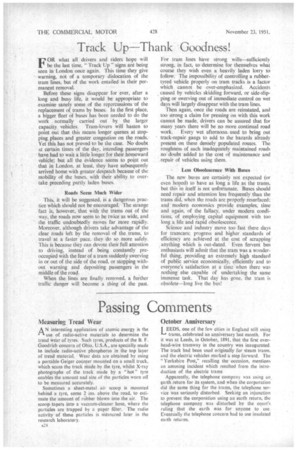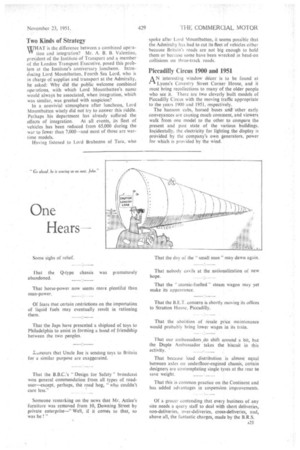Passing Comments
Page 26

Page 27

If you've noticed an error in this article please click here to report it so we can fix it.
Measuring Tread. Wear
AN interesting application of atomic energy is the use of radio-active. materials to determine the tread wear of tyres. Such tyres, products of the B. F. Goodrich concern of Ohio, U.S.A., are specially made to include radio-active phosphorus in the top layer of tread material. Wear data are obtained by using a portable Geiger counter mounted on a small truck, which scans the track made by the tyre, whilst X-ray photographs of the track made by a "hot" tyre enables the amount and size of the particles worn off to be measured accurately.
Sometimes a sheet-metal air scoop is mounted behind a tyre, some 2 ins, above the road, to estimate the amount of rubber blown into the air. The scoop tapers into a vacuum-cleaner hose, where the particles are trapped by a paper filter. The radio activity of these particles is measured later in the research laboratory.
A24
October Anniversary
EEDS, one of the few cities in England 'still using 1^4 trams, celebrated an anniversary last month. For it was at Leeds, in October, 1891, that the first overhead-wire tramway in the country was inaugurated. The track had been used originally for steam trams, and the electric vehicles marked a step forward. The "Yorkshire Post," recalling the occasion, mentions an amusing incident which resulted from the introduction of the electric trams Apparently, the telephone company was using au. earth return for its system, and when the corporation did the same thing for the trams, the telephone service Was seriously disturbed. Seeking an injunction to prevent the corporation using an earth return, the telephone company was disturbed by the court's ruling that the earth was for anyone to use. Eventually the telephone concern had to use insulated earth returns.
Two Kinds of Strategy
WHAT is the difference between a combined opera" tion and integration? Mr. A. B. B. Valentine, president of the Institute of Transport and a member of the London Transport Executive, posed this problem at the Institute's anniversary luncheon. Introducing Lord Mountbatten, Fourth Sea Lord, who is in charge of supplies and transport at the Admiralty, he asked: Why did the public welcome combined operations, with which Lord Mountbatten's name • would always be associated, when integration, which was similar, was greeted with suspicion?
In a convivial atmosphere after luncheon, Lord Mountbatten wisely did not try to answer this riddle. Perhaps his department has already suffered the effects of integration. At all events, its fleet of vehicles has been reduced from 65,000 during the war to fewer than 7,000—and most of those are wartime models.
Having listened to Lord Brabazon of Tara, who spoke after Lord Mountbatten, it seems possible that the Admiralty has had to cut its fleet of vehicles either 'because Britain's roads are not big enough to hold them or because some have been wrecked in head-on collisions on three-track roads.
Piccadilly Circus 1900 and 1951
A N interesting window decor is to be found at 1-1 Lyons's Coventry Street Corner House, and it must bring recollections to many of the older people who see it. There are two cleverly built models of Piccadilly Circus with the moving traffic appropriate to the years 1900 and 1951, respectively.
The hansom cabs, horsed buses attid other early. conveyances are causing much comment, and viewers, walk from one model to the other to compare the present and past state of the various buildings. Incidentally, the electricity for lighting the display is provided by the company's own generators,' power for which is provided by the wind.












































































